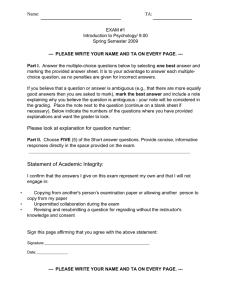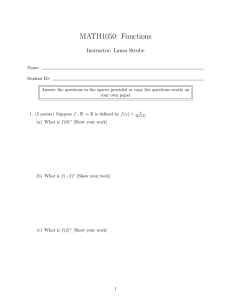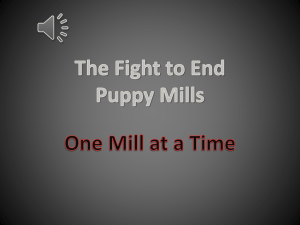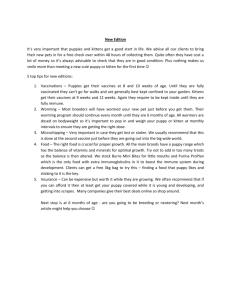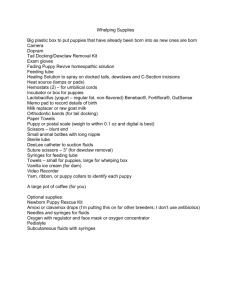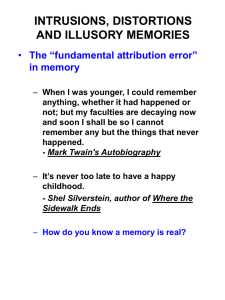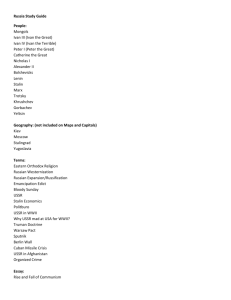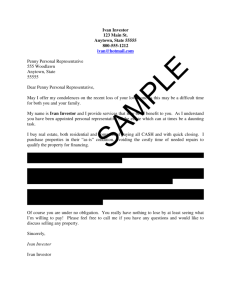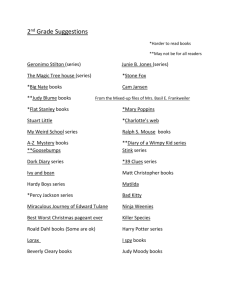Document 13363982
advertisement
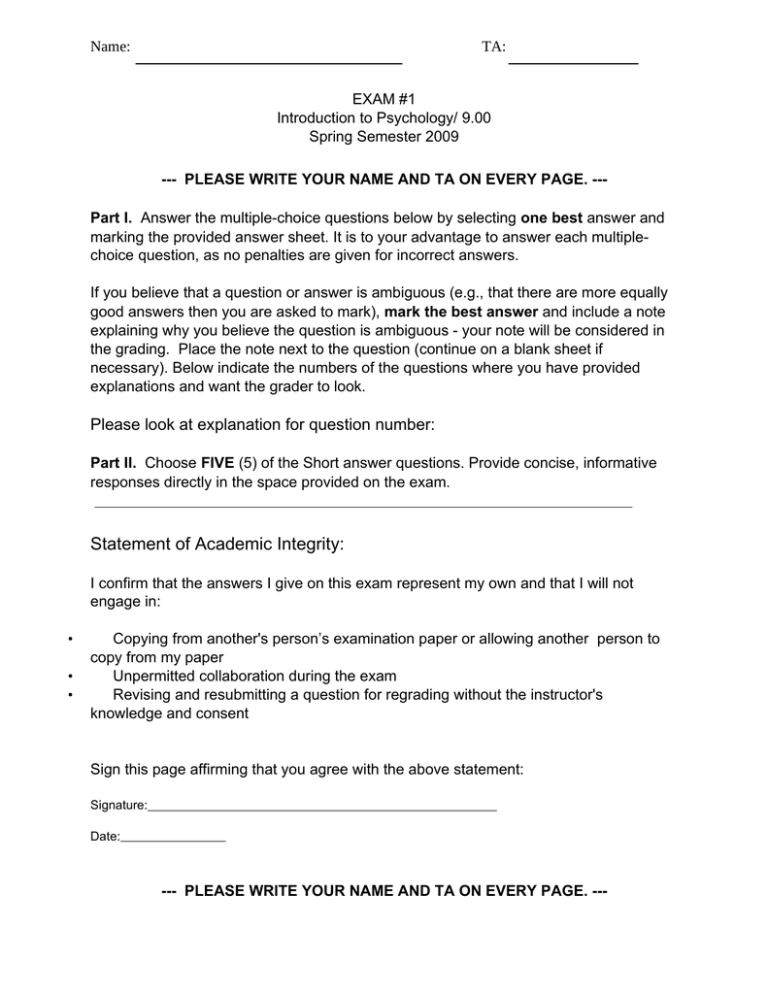
Name: TA: EXAM #1 Introduction to Psychology/ 9.00 Spring Semester 2009 --- PLEASE WRITE YOUR NAME AND TA ON EVERY PAGE. --­ Part I. Answer the multiple-choice questions below by selecting one best answer and marking the provided answer sheet. It is to your advantage to answer each multiplechoice question, as no penalties are given for incorrect answers. If you believe that a question or answer is ambiguous (e.g., that there are more equally good answers then you are asked to mark), mark the best answer and include a note explaining why you believe the question is ambiguous - your note will be considered in the grading. Place the note next to the question (continue on a blank sheet if necessary). Below indicate the numbers of the questions where you have provided explanations and want the grader to look. Please look at explanation for question number: Part II. Choose FIVE (5) of the Short answer questions. Provide concise, informative responses directly in the space provided on the exam. Statement of Academic Integrity: I confirm that the answers I give on this exam represent my own and that I will not engage in: • Copying from another's person’s examination paper or allowing another person to copy from my paper • Unpermitted collaboration during the exam • Revising and resubmitting a question for regrading without the instructor's knowledge and consent Sign this page affirming that you agree with the above statement: Signature: Date: --- PLEASE WRITE YOUR NAME AND TA ON EVERY PAGE. --­ Name: TA: Questions from Lecture and The Man Who Mistook his Wife for a Hat _______ 1. Sacks describes two women, Mrs. O'C and Mrs. O'M, with "musical epilepsy" in which the women experienced hearing songs due to pathology in which lobe? A. parietal B. temporal C. occipital D. frontal _______ 2. Sacks describes the case of Donald, who could not remember killing his girlfriend while under the influence of PCP. After contusions to what brain regions did Donald appear to recover memory for the murder? A. parietal B. temporal C. occipital D. frontal _______ 3. Sacks describes Professor P, a musician who became a prosopagnosic patient. Professor P failed to recognize all of the following, except for one. Select the one answer below describing something Professor P could recognize by sight. A. faces of his family B. abstract shapes like a cube C. emotional expression of faces in movies D. a rose _______ 4. Sacks describes a man who claims that he has a severed human leg in his bed when it is actually his own leg. If this patient is like those described by Ramachandran in his studies of similar anosagnosic patients, Sacks would have found which ONE of these with this patient? A. the patient would use that leg for practical purposes B. the patient would agree that it is his leg if offered money C. the patient would agree that it is his own leg if cold water is placed in his left ear D. the patient would agree that he himself has a problem with his own left leg Name: TA: _______ 5. An experiment had subjects either (Forecaster Group) hear about an individual make a racist comment or (Experiencer Group) actually be present when an individual made a racist comment. Then, these subjects were asked how they felt and whether they would select the individual who made the racist comment as a partner for an anagram task. The findings from this study were, in general, that A. subjects in both Groups felt bad about the comment, and did not tend to select the individual who made the racist comment as a partner B. subjects in both Groups felt bad about the comment, but still tended to select the individual who made the racist comment as a partner C. subjects in the Forecaster Group felt bad about the comment and did not tend to select the individual who made the racist comment as a partner, but subjects in the Experiencer Group felt ok about the comment and did tend to select the individual who made the racist comment as a partner D. subjects in the Experiencer Group felt bad about the comment and did not tend to select the individual who made the racist comment as a partner, but subjects in the Forecaster Group felt ok about the comment and did tend to select the individual who made the racist comment as a partner _______ 6. If two groups of patients with fever are given either (a) a drug or (b) a placebo, and the temperatures of the patients are used as the measure of how well the drug did, then A. drug vs. placebo and temperature are independent measures B. drug vs. placebo and temperature are dependent measures C. drug vs. placebo is the dependent measure, and temperature is the independent measure D. drug vs. placebo is the independent measure, and temperature is the dependent measure _______ 7. Empirical evidence supports which one of the conclusions below? A. students do better in a course when the teacher sets paper deadlines than when the students set paper deadlines B. the Rorschach inkblot test is a valid psychological test C. medical school interviews help identify applicants who perform better in medical school and are more likely to successfully complete medical school D. the medical or clinical experience of a therapist increases the likelihood that psychotherapy will help a person _______ 8. Some measures of brain function reveal what brain region is necessary (causal) for a mental ability, and other brain measures reveal what brain region is Name: TA: associated (correlated) with a mental ability. Which answer below contains only causal measures? A. lesions and functional magnetic resonance imaging (fMRI) B. fMRI and transcranial magnetic stimulation (TMS) C. lesions and TMS D. fMRI and diffusion tensor imaging (DTI) _______ 9. Which method primarily measures white matter, rather than grey matter? A. fMRI B. ERP/EEG C. PET D. DTI _______ 10. Which is the correct order in the brain of visual processing from the outer world? A. primary visual cortex, rods & cones, retinal ganglion cells, lateral geniculate nucleus B. retinal ganglion cells, rods & cones, lateral geniculate nucleus, primary visual cortex C. rods & cones, lateral geniculate nucleus, retinal ganglion cells, primary visual cortex D. rods & cones, retinal ganglion cells, lateral geniculate nucleus, primary visual cortex _______ 11. Infants prefer _________ visual displays, and at 6 months recognize monkey faces ______ human faces. A. bottom-heavy; worse than B. top-heavy; as well as C. top-heavy; worse than D. bottom-heavy; as well as _______ 12. In an experiment with infants who were cortically blind in one visual field due to hemispherectomies, the infants saw a central target, and then a peripheral target in either the good or bad visual field. In the Competition condition, the central target remained on while the peripheral target was shown. In the NonCompetition condition, the central target disappeared when the peripheral target was shown. The infants were tested at several times as they developed. The key findings were that: A. as they developed, the infants usually looked at the peripheral targets in the blind field in the Non- Competition condition, but seldom in the Competition condition B. infants seldom looked at the peripheral targets in the blind field in either the Competition or Non-Competition conditions Name: TA: C. infants almost always looked at the peripheral targets in the blind field in both the Competition and Non-Competition conditions D. as they developed, the infants usually looked at the peripheral targets in the blind field in the Competition condition, but seldom in the NonCompetition condition _______ 13. In one study of blindsight, monkeys had ablation of the left striate cortex and the splenium of the corpus callosum. In the first experiment, monkeys responded to a light coming on by touching the location of the light on a monitor. In the second experiment, monkeys did the same task, but also touched a specified location when they believed that no light came on (blank trials). The findings were: A. monkeys identified lights coming on in both visual fields in both experiments B. monkeys identified lights coming on only in the left visual field in both experiments C. monkeys identified lights coming on in both visual fields in the second experiment, but only in the left visual field in the first experiment D. monkeys identified lights coming on in both visual fields in the first experiment, but only in the left visual field in the second experiment _______ 14. A variety of results, including results from a spatial cuing task from Posner, indicate that patients with spatial neglect due to right posterior lesions have a primary deficit in A. disengaging attention from the right field B. engaging attention in the left field C. moving attention to the left field D. disengaging attention from the left field _______ 15. In conditioning, partial reinforcement (relative to constant reinforcement) leads to learning that A. occurs faster, and is more resistant to extinction B. occurs slower, and is less resistant to extinction C. occurs slower, and is more resistant to extinction D. occurs faster, and is less resistant to extinction _______ 16. “Negative contrast” refers to the finding that rat performance in a maze is worst for rats who A. receive a large reward throughout the experiment B. receive a small reward throughout the experiment C. initially receive a small reward and then are switched to a large reward D. initially receive a large reward and then are switched to a small reward _______ 17. In a study by Intriligator and Cavanaugh, the following graphic was shown, and subjects were instructed to fixate on the cross while trying to attend to Name: TA: features of the lines: What does this display allow us to claim about the attentional system? A. When looking at the cross, we are unable to attend to the lines, and thus show “change blindness” to even dramatic changes in the line display. B. Both the visual system and attentional system are better at processing horizontal lines than vertical lines. C. The resolution of the attentional system is not as precise as the resolution of the visual system. D. The resolution of the attentional system is more precise than the resolution of the visual system. _______ 18. In shadowing experiments like the one performed by Cherry, subjects repeat (“shadow”) the words coming into the attended ear, while another audio stream is playing in the unattended ear. Which of the following types of change is a subject likely to report noticing about the unattended stream? A. The language of the unattended stream changes from English to Spanish. B. The unattended stream changes from forwards-speech to backwardsspeech C. The voice changes from a deep male voice to a high-pitched female voice D. None of the above _______ 19. Green and Bavelier experimented with using video game training to increase the number of objects that could be tracked simultaneously. Subjects measured their baseline tracking capacity, then trained with one of: the blockstacking game “Tetris”, an action game, or a non-gaming control condition. What best describes the effect on tracking capacity after training? A. Only subjects who trained on the action game showed improvements in tracking capacity. B. Subjects who trained either Tetris or the action game showed improvements, but the control group did not. C. All subjects showed improvements from the pre-test to the post-test. D. No statistically significant trends were seen among any of the three groups. Name: TA: _______ 20. A split-brain patient is simultaneously shown the image of a tricycle in his left visual hemifield and a platypus in his right hemifield. Which of the following scenarios is most likely to happen? A. If asked to draw the object with his left hand, the patient will draw a tricycle. If asked to say what image he saw, the patient will declare he saw a platypus. B. If asked to draw the object with his right hand, the patient will draw a tricycle. If asked to say what image he saw, the patient will declare he saw a platypus. C. If asked to draw the object with his left hand, the patient will draw a platypus. If asked to say what image he saw, the patient will declare he saw a tricycle. D. If asked to draw the object with his right hand, the patient will draw a platypus. If asked to say what image he saw, the patient will declare he saw a tricycle. Book Chapter Questions: Professor Henry Higgins' laboratory just finished a study on music and language. They asked whether there was any relationship between musical expertise and the ability to learn a foreign language. In the first part of their study, participants took a test of musical ability, and then they learned how to say 100 words in the new language. The results of this experiment are in the graph below. ScoreonMusical AbilityTest 100 80 60 40 20 0 0 20 40 60 80 100 ForeignLanguageWordsLearned _______ 21. Prof. Higgins asked four of his grad students to provide an explanation of the data. Based on your knowledge of correlations, whose explanation do the data best and most accurately support? Name: TA: A. Tracy: "People who learned more words also had greater musical ability, therefore music and language rely on the same mental processes." B. Jean: "People who learned more words were also more likely to have greater musical ability, therefore we can use someone's score on the music test to predict how many foreign words they will learn." C. Sam: "People who learned more words also tended to have better musical ability, therefore having good language skills helps you be a better musician." D. Pat: "People who had better musical ability learned more words, therefore being a good at music helps you learn a foreign language." To explore her hypothesis, Sam designed the following experiment. Two _______ 22. groups of participants took the musical ability test. Group “A” came back to the lab every day and practiced memorizing words. Group “B” came back to the lab every day and read the same lists of words, but did not memorize them. Then the two groups took the music ability test again. Sam hypothesized that having to memorize the words would cause people to do better on the music test. In Sam's experiment: A. Group A is the independent variable; Group B is the dependent variable. B. Group A is the dependent variable; Group A is the independent variable. C. Group A is in the experimental condition; Group B is in the control condition. D. Group A is in the control condition; Group B is in the experimental condition. When Sam looked at the data, she found that the mean music test score _______ 23. after training for Group A was 70.4, and the mean test score for Group B after training was 55.8. Sam concludes that Group A had better musical ability after the experiment. Which of the following details would be a reason for Prof. Higgins to be skeptical of Sam’s conclusion? A. A small number of participants in Group A had much higher scores than the rest of that group. B. A small number of participants in Group B had much higher scores than the rest of that group C. Many people in Group B had exactly the same score on the test. D. The lowest score in Group A was lower than the highest score in Group B. Sam and Prof. Higgins are excited about the data and want to submit _______ 24. them to a conference. They want to be confident the effect they have found is real, and that it is not due to chance. To ensure this, Sam and Prof. Higgins should subject their data to: Name: TA: A. Correlational analysis B. Selective reporting C. Descriptive statistics D. Inferential statistics _______ 25. At the conference, Professor Zoltan Karpathy, another psychologist, points out what he claims is a serious problem with Sam’s experiment. He notices that Sam always knew whether a participant was in Group A or whether they were in Group B. Prof. Karpathy claims that Sam’s data might be contaminated because of: A. Random assignment of participants B. Participants’ response bias C. Experimenter expectancy effects D. Sam’s sampling bias _______ 26. Prof. Higgins agrees that Sam’s data might have the confound pointed out by Prof. Karpathy. When they return from the conference, Prof. Higgins asks Sam to redo the experiment. What must she do differently this time to avoid the confound Prof. Karpathy mentioned? A. Use random assignment of participants to groups B. Use a double-blind design C. Use a larger sample size D. Use a different dependent variable _______ 27. Which symptom would a patient with hippocampal damage most likely exhibit? A. Poor working memory B. Inability to form new procedural memories C. Impaired memory of events that occurred long prior to the hippocampal damage D. Inability to form new declarative memories _______ 28. Which of the following can be used to determine a causal relationship between brain structure and behavior? A. A brain scan of a schizophrenic man shows that the parts of the brain that process sensory information are significantly larger than in nonschizophrenics B. A brain scan of a schizophrenic man shows that the parts of the brain that process sensory information are significantly more active than in nonschizophrenics C. Neither A and B D. Both A or B _______ 29. Myelin degeneration is a major symptom of which disease? A. Alzheimer's disease Name: TA: B. multiple sclerosis C. Parkinson's disease D. Huntington's disease _______ 30. A. B. C. D. Which of the following is INCORRECT? MRI measures brain structure fMRI measures changes in blood oxygenation EEG measures brain structure CT measures brain structure _______ 31. In regards to drugs and how they act upon receptors in the brain, an agonist is to antagonist as: A. mimic is to block B. block is to mimic C. constructive is to destructive D. non-competitive is to competitive _______ 32. The sympathetic nervous system is to the parasympathetic nervous system as: A. fight is to flight B. speed up is to slow down C. flight is to fight D. central is to peripheral _______ 33. A. B. C. D. All of the following provide visual information about distance EXCEPT Retinal disparity Texture gradient Good continuation Motion parallax _______ 34. The region of the retina which contains the most cones and provides the most detailed visual information is the A. iris B. fovea C. cornea D. pupil _______ 35. A. B. C. D. All of the following are true about cones EXCEPT: Cones are less in number than rods. Cones are responsible for color vision. Most people have three different types of cones. Cones are more sensitive to light than rods. _______ 36. According to the opponent-process theory, if you stare at a blue square for awhile (e.g., 60 seconds) and then look at a plain sheet of white paper you will see an afterimage of the square in which hue? Name: TA: A. B. C. D. yellow blue black red _______ 37. Which of these might describe a patient with damage to the visual areas of the temporal lobe?? A. She cannot see movement, but can see color and shape. B. She cannot perform visually-guided motions, but can identify objects. C. She cannot identify objects, but can perform visually-guided motions. D. She has lost all visual function. _______ 38. Using knowledge of an object’s size to determine its distance is an example of A. bottom-up processing B. top-down processing C. Gestalt organization D. stereopsis _______ 39. If John's hearing is impaired due to a constant ringing in his ears beyond his control, then he most likely has: A. nerve deafness B. tinnitus C. conduction deafness D. prosopagnosia _______ 40. Which of the following is the primary structure that allows one to maintain his or her balance? A. cochlea B. middle ear C. basilar membrane D. semicircular canals _______ 41. Closing your eyes and then touching your nose with your forefinger most accurately illustrates which of the following? A. B. C. D. kinesthetic sense vestibular sense somasthetic sense magnetic sense Name: TA: _______ 42. What (and why) is the odd one out in this list: Vodka, Amphetamines, Cocaine A. Vodka because it is a depressant and everything else is a stimulant B. Cocaine because it is a stimulant and everything else is a depressant C. Cocaine because it is a depressant and everything else is a stimulant D. Amphetamines, because they produce addiction extremely quickly, while the others take longer. _______ 43. Which of the following is FALSE: A. Prior to the invention of EEG, scientists believed that sleep constituted one single state B. REM is an acronym for rapid eye movement C. The area of the brain controlling most functions of sleep is the suprachiasmatic nucleus D. Sleep stages 3 and 4 are referred to as slow-wave sleep _______ 44. During REM, what is NOT true: A. your eyes flutter back and forth B. you dream C. your EEG resembles waking state D. your EEG has sleep spindles _______ 45. You have a terrifying dream that you are drowning. Which of the following is the most likely interpretation of this dream according to the activation-synthesis hypothesis? A. you are experiencing extreme anxiety in your waking life, and your mind is subconsciously alerting you that you’re overwhelmed B. random brain activations are being constructed into a coherent story C. you are experiencing extreme anxiety in your waking life, and your brain is trying to relieve the stress by reenacting it in your dream D. Your mind is reenacting a life-long fear of water. This dream is likely to recur often. (Questions 47-50) use the following story: Young Ivan has a phobia of puppies. Whenever he sees a puppy wagging its tail, he freezes and starts crying. On the other hand, he likes chocolate-covered strawberries. Observing his behaviors, Ivan’s mom thought of a few ways to cure his phobia of puppies. Mom tried putting a puppy repeatedly in front of Ivan. Every time she showed him the puppy, Mom also showed him a chocolate-covered strawberry. After doing that five times, Mom discovered that Ivan started crying whenever he saw a chocolate-covered strawberry, even if the puppy was not in his sight. Choose the appropriate answer for the following questions. Name: _______ 46. TA: What is the conditioned stimulus (CS) in this learning process? A. Chocolate-covered strawberries. B. Mom C. Puppies D. Crying _______ 47. Mom decided that the first method didn’t work that well because Ivan started crying after seeing a chocolate-covered strawberry, so she decided to show just the chocolate-covered strawberries repeatedly without showing him the puppy. After doing this about ten times, Ivan did not cry anymore when he saw the strawberries. What is the process involved in this phenomenon? A. Negative Reinforcement B. Extinction C. Insight Learning D. Successive approximations _______ 48. However, after a few days of no exposure to the chocolate-covered strawberries, when Mom put a chocolate-covered strawberry on the table, Ivan was scared of the strawberry and ran away. What is the process involved in this phenomenon? A. Latent Learning B. Habituation C. Spontaneous Recovery D. Sensitization _______ 49. Instead of giving him a chocolate-covered strawberry, mom thought about giving him a sticker that says “good job!” with a smiley face. Choose the INCORRECT choice from the following. A. this is an example of a positive reinforcement B. mom is using a behavior modification technique to change Ivan’s behavior C. the sticker is used as a secondary reinforcer D. this type of immediate reinforcement will change Ivan’s behavior more slowly than delayed reinforcement _______ 50. In Tolman’s experiment, the rats developed a cognitive map of a maze that they ran in, but they did not use the map until they were motivated to do so by the reinforcement. This is an example of: A. Operant conditioning B. Latent learning C. Negative reinforcement D. Discrimination Name: TA: Short Answer Questions (Answer 5 of the following 10 questions) 1. Which cortical lobe corresponds to each sentence? (Best single answer per sentence) a. ___________________________ As a young man walked into a club to meet up with his friends, he saw an attractive young lady on the far side of the room. b. ___________________________ She was clearly out of his league, and using his better judgment, he decided not to go ask her for a dance. c. ___________________________ Instead, he bought a drink and relaxed, listening to the DJ's music. d. ___________________________ A few minutes later, he felt a tap on his shoulder; it was the young lady, and she wanted to dance with him! 2. Name four common methods that scientists use to study the relationship between genes, the environment, and behavior. a. ___________________________ b. ___________________________ c. ___________________________ d. ___________________________ 3. Define four of the following five Gestalt Laws of Organization (Only the first four will be graded, if you answer all five): a. Proximity: b. Continuity c. Similarity d. Closure e. Good Form Name: TA: 4. Which parts of the sensory system match the following definitions? A) The sheet of light-transducing cells at the back of the eye: __________ B) The organ in the inner ear that transduces sound energy into nerve impulses: __________ C) The cord that carries information from the eye to the brain (its location corresponds to the blind spot in your vision): __________ D) The chemical receptors located on the sides of the papillae on the tongue __________ 5. Which sensory disruptions are described below? a. After suffering right parietal lobe damage, the patient seems unable to see anything on her left side. __________ b. The patient can identify most common objects but is completely unable to identify faces. __________ c. The patient has impaired hearing after suffering damage to the hair cells in the inner ear. __________ deafness d. The patient is blind in the center of the visual field, due to damage to the cells in the center of the retina. __________ 6. Ivan is still afraid of puppies. Mom decided it’s important that Ivan can touch puppies so that he learns that they’re harmless. She put a puppy at a distance from Ivan and gave him a chocolate-covered strawberry when he didn’t cry of fear. Then she brought the puppy a bit closer and gave him another strawberry if he didn’t cry. She repeated this process, bringing the puppy closer and encouraging Ivan to reach out his hand to the puppy. Finally Ivan could pat a puppy on its head to get a chocolate-covered strawberry. This is an example of ____________________ through ____________________________. The ability to emit this behavior in response to a similar stimulus, such as a kitten, is _______________. However, if Ivan responds only to puppies and nothing else, this ability to respond to a particular stimulus is called _____________________________. 7. Mom wants to make sure that Ivan completely overcomes his fear of puppies. When Ivan reaches towards a puppy and pats it, Mom will give him a chocolate-covered strawberry as a reward. She thought of two ways to do this: Plan A is to reward him when Ivan pats the puppy every 5 times on average, but sometimes after 3 times and sometimes after 7 times. The reinforcement schedule used here is ____________________. Plan B is to reward him for patting a puppy for the first time, but not give him more strawberries for the next 10 minutes regardless of how many times she touches the puppy. Repeat the same for the next 10 minutes, by rewarding him on the first response during that 10-minute period. The reinforcement schedule used here is _________________________. The first type of reinforcement schedule induces a MORE/LESS (circle one) consistent rate of responding than does the second type of reinforcement schedules. Name: TA: After a while, Ivan seemed to have overcome his fear of puppies. One day Mom was trying to give the puppy a bath. She put the puppy into the bathtub, turned on the shower and shampooed him, and she noticed that Ivan was standing behind her watching what she was doing. A few days later, Mom saw Ivan trying to put the puppy in the kitchen sink and trying to wash the puppy with dish soap. The process involved in Ivan’s behavior is ______________________________. 8. Dreaming: a. Provide an example of a dream’s manifest content: b. Provide an example of a dream’s latent content: c. Why do we dream? Take one of the proposed theories and provide one way in which this may be supported: d. Take the same theory from part c and provide a way in which it may be refuted: 9. Name and define two types of meditation: a. b. 10. The book mentioned many individual brain structures. Pick four from the amygdala, basal ganglia, reticular formation, medulla, cerebellum, thalamus or hypothalamus and describe their primary functions: a. b. Name: c. d. TA: MIT OpenCourseWare http://ocw.mit.edu 9.00SC Introduction to Psychology Fall 2011 For information about citing these materials or our Terms of Use, visit: http://ocw.mit.edu/terms.
